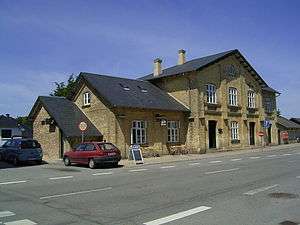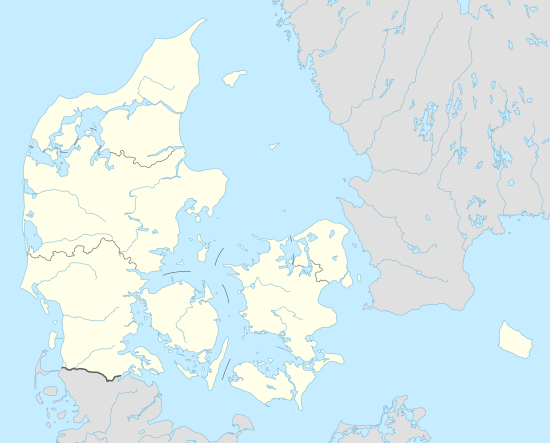Skørping station
Skørping station is a Danish railway station serving the railway town of Skørping in Himmerland south of Aalborg, Denmark.
Skørping | |||||||||||||||||||||
|---|---|---|---|---|---|---|---|---|---|---|---|---|---|---|---|---|---|---|---|---|---|
| railway station | |||||||||||||||||||||
 Front facade of Skørping station | |||||||||||||||||||||
| Location | Sverriggårdsvej 4 DK-9520 Skørping Denmark | ||||||||||||||||||||
| Coordinates | 56°50′09″N 9°53′14″E | ||||||||||||||||||||
| Owned by | Banedanmark | ||||||||||||||||||||
| Operated by | DSB Nordjyske Jernbaner[1] | ||||||||||||||||||||
| Line(s) | Randers-Aalborg Line | ||||||||||||||||||||
| Platforms | 2 | ||||||||||||||||||||
| Tracks | 3 | ||||||||||||||||||||
| History | |||||||||||||||||||||
| Opened | 1869[2] | ||||||||||||||||||||
| Services | |||||||||||||||||||||
| |||||||||||||||||||||
| Location | |||||||||||||||||||||
 Skørping Location within Denmark | |||||||||||||||||||||
The station is located on the Randers-Aalborg Line from Randers to Aalborg and is the southern terminus of the Aalborg Commuter Rail service. It opened in 1869. The train services are currently operated by the railway companies DSB and Nordjyske Jernbaner.[1]
History

The station opened in 1869 with the opening of the Randers-Aalborg railway line from Randers to Aalborg.[2] It survived a series of station closures in the 1970s. In 2003 it became the southern terminus of the new Aalborg Commuter Rail service.[3]
Operations
The train services are operated by the railway companies DSB and Nordjyske Jernbaner.[1][4] The station offers direct InterCity services to Copenhagen and Aalborg, regional train services to Aarhus and Aalborg as well as commuter train services to Aalborg.
In literature
Danish writer Herman Bang's novel Ved Vejen was inspired by an incident in 1883 when he was passing through Skørping Station. He noticed a young woman at the window who, her pale face couched in her hands, stared after his departing train. In the introduction to Stille Eksistenser he explains: "For the rest of the journey, I could see the woman's face between the flowers. Her look was not quite one of longing — longing would have perhaps fluttered to death by breaking its wings in such tight confines — just a quite resignation, a waning sorrow. And when the train had slid by, she would be peering out with the same look over Egnens Lyng — over the dreary plain."
Bang started writing the novel in 1885 in Vienna, after remembering Skørping Station: "It was in one of those windows behind the flowers that I saw her face, a face which I had not been able to erase from my memory for two years and which, as if a painter, I felt like drawing in soft, melancholic, almost blurry lines and using it as a kind of cover illustration for this book."[5]
References
- "Om Nordjyske Jernbaner" (in Danish). Nordjyske Jernbaner. Retrieved 22 July 2019.
- Jensen (1976), p. 11.
- "Aalborg Nærbane" (in Danish). Nordjyllands Jernbaner. Retrieved 2 August 2020.
- "Historien bag Nordjyske Jernbaner" (in Danish). Nordjyske Jernbaner. Retrieved 23 July 2019.
- Johannes Fibiger, "Hvordan Bang blev forfatter", Forfatterweb. (in Danish) Retrieved 11 February 2013.
Bibliography
- Jensen, Niels (1976). Nordjyske jernbaner (in Danish). Copenhagen: J. Fr. Clausens Forlag. ISBN 87-11-03756-3.
External links
| Wikimedia Commons has media related to Skørping Station. |
- (in Danish) Banedanmark
- (in Danish) DSB
- (in Danish) Nordjyllands Jernbaner